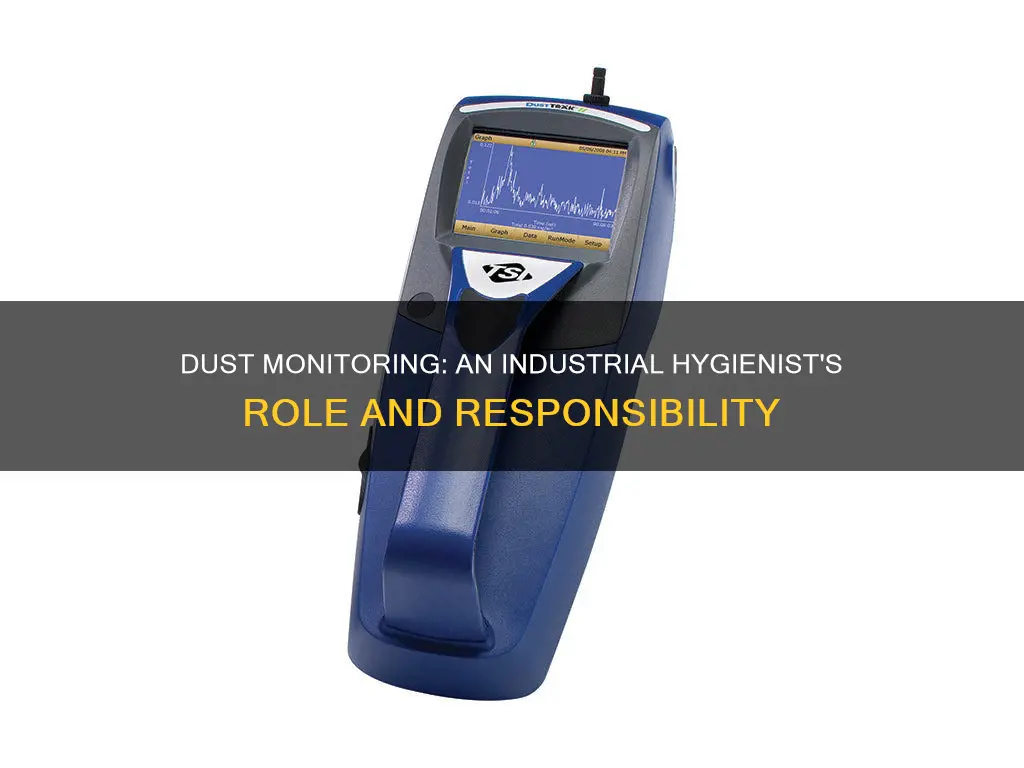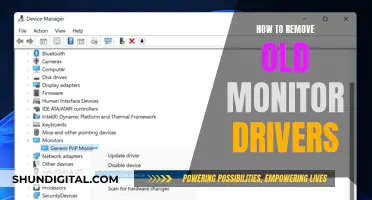
Industrial hygiene is a critical practice for maintaining a safe and sanitary work environment. It involves identifying, evaluating, and controlling workplace conditions that may cause injuries or illnesses. Industrial hygienists play a crucial role in this process by performing risk assessments and implementing solutions to protect workers from various hazards. One common type of hazard is dust, which can be monitored by industrial hygienists to ensure worker safety. Dust monitoring is particularly important in industries such as construction, where silica dust is prevalent, and manufacturing, where various types of dust may be present. Real-time dust monitoring solutions allow industrial hygienists to observe peaks in air exposures and dust settling times, helping to manage exposure at the source and support employee understanding of health risks.
| Characteristics | Values |
|---|---|
| Purpose | To protect workers from hazards present in the workplace, including dust, fumes, mist, aerosols, and fibres. |
| Role | Observe workplace conditions and evaluate the best course of action to remove or reduce hazards or contaminants. |
| Hazards | Air contaminants, chemical hazards, biological hazards, physical hazards, and ergonomic hazards. |
| Air contaminants | Particulate and vapour contaminants, including dust, fumes, mist, aerosols, and fibres. |
| Chemical hazards | Harmful chemical compounds in the form of solids, liquids, gases, mists, specks of dust, fumes, and vapours that can be inhaled, absorbed through the skin, or ingested. |
| Biological hazards | Bacteria, viruses, fungi, and other living organisms that can cause acute and chronic infections by entering the body through breaks in the skin. |
| Physical hazards | Excessive levels of ionizing and non-ionizing electromagnetic radiation, noise, vibration, illumination, and temperature. |
| Ergonomic hazards | Excessive vibration and noise, eye strain, repetitive motion, heavy lifting problems, and improperly designed tools or work areas. |
| Sampling types | Integrated, direct read (or instantaneous), breathing zone, area, or bulk. |
What You'll Learn
- Dust monitoring helps to identify and manage exposure to dust at its source
- Real-time dust monitoring reveals air exposure peaks and dust settling times
- Dust monitoring supports training programmes and employee understanding of health risks
- Dust monitoring is a legal requirement for carcinogens such as respirable crystalline silica
- Dust monitoring is necessary to ensure compliance with Workplace Exposure Limits

Dust monitoring helps to identify and manage exposure to dust at its source
Dust monitoring is an essential part of maintaining a safe and sanitary work environment. It involves anticipating, recognising, evaluating, and controlling conditions that may cause injuries or illnesses. Dust monitoring helps to identify and manage exposure to dust at its source.
Dust monitoring is the process of detecting and assessing the particulate matter (PM) in the air. Thissection gives a basic introduction to some common language around particulate matter and dust monitoring. PM is a mix of solid and liquid droplets suspended in the air. Once known, controls can be implemented to reduce the risk of inhalation before severe consequences arise.
Each work environment is different, so there are various options for dust monitoring technologies. They provide different levels of accuracy and depth, so there is a solution for every situation, environment, and organisation. For example, the Air XD is a modern dust monitor that provides in-depth detail on particulate matter in the air and covers a wide spectrum of potentially hazardous substances.
Dust monitoring can help identify the source of dust exposure. For example, in construction, silica dust is created when undertaking cutting, drilling, grinding, and polishing activities. In catering, flour dust is often airborne. In woodworking, workers are exposed to fine wood dust particles.
Section on how dust monitoring helps to identify and manage exposure to dust at its source. Dust monitoring can help identify the source of dust exposure and put in place measures to control it. For example, if dust exposure is coming from a specific machine, that machine can be enclosed or the process can be changed to reduce dust creation. If dust is coming from materials being used, employers can provide Personal Protective Equipment (PPE) such as protective clothing and respiratory protective equipment (RPE).
In summary, dust monitoring is a critical tool for identifying and managing exposure to dust at its source. By understanding the source of dust exposure, employers can take appropriate action to protect the health and safety of their employees.
Unlocking GPU Usage Monitoring: A Unified Approach
You may want to see also

Real-time dust monitoring reveals air exposure peaks and dust settling times
Real-time dust monitoring is an essential part of industrial hygiene, which aims to maintain a safe and sanitary work environment. Industrial hygienists are responsible for anticipating, recognising, evaluating, and controlling conditions that may cause injuries or illnesses in the workplace.
Dust monitoring is a critical aspect of this process, as dust particles can pose a significant health risk to workers. By utilising real-time dust monitoring equipment, occupational hygienists can gain valuable insights into the levels of dust exposure and settling times. This allows them to make data-driven decisions to protect their employees' health and ensure compliance with regulations.
One of the key advantages of real-time dust monitoring is the ability to identify peaks in air exposures. These peaks can be significantly higher than the Workplace Exposure Limits (WELs) but may not be captured by 8-hour Time Weighted Averages. While this may not be a compliance issue, it raises health concerns that need to be addressed. By monitoring in real-time, hygienists can identify these peaks and implement measures to reduce exposure at the source.
Additionally, real-time dust monitoring helps in understanding dust settling times. This information is crucial in determining how long employees should keep their masks on after completing a job to ensure they are protected from any lingering dust particles.
The process of dust monitoring involves sampling and analysis. Sampling types include integrated, direct read, breathing zone, area, or bulk sampling. By taking samples and recording changes, hygienists can gather valuable data on the contaminants present in the workplace. This data then informs the analysis and evaluation process, where the hygienist assesses the risks and recommends corrective actions.
Furthermore, real-time dust monitoring contributes to training programmes and promotes employee understanding and compliance. By involving employees in the monitoring process, hygienists can foster a culture of safety and encourage workers to actively look for and report hazards.
In conclusion, real-time dust monitoring is a powerful tool for industrial hygienists to protect worker health. It provides valuable insights into air exposure peaks and dust settling times, enabling hygienists to make informed decisions, implement effective controls, and ensure a safe working environment for all.
Monitor Refresh Rates: Finding Your Hertz
You may want to see also

Dust monitoring supports training programmes and employee understanding of health risks
Dust monitoring is a critical aspect of maintaining a safe and healthy work environment, and it plays a vital role in supporting training programmes and enhancing employee understanding of health risks. Real-time dust monitoring allows occupational hygienists and employees to visualise peaks in air exposures and understand how long dust particles remain airborne, even after a job is finished. This knowledge helps employees comprehend the importance of keeping their masks on for an extended period.
Dust monitoring also highlights the difference between compliance and health perspectives. While dust levels may be within Workplace Exposure Limits on 8-hour Time Weighted Averages, real-time monitoring may reveal higher peaks, which can be a health concern. This information is crucial for managing exposure at the source and ensuring employee compliance with health and safety regulations.
Additionally, dust monitoring contributes to training programmes by providing data on the effectiveness of control measures and respiratory protective equipment (RPE). By understanding the limitations of RPE, employees can better appreciate the necessity of adhering to health and safety protocols. Dust monitoring data can also be used to identify previously overlooked peak exposures, such as silica dust, which can lead to accelerated silicosis.
Furthermore, dust monitoring supports employee understanding of health risks by identifying the types and sources of dust in the workplace. For example, in the construction industry, silica dust is a common hazard created by cutting, drilling, grinding, and polishing activities. By understanding the specific hazards they face, employees can take the necessary precautions to protect their health.
In conclusion, dust monitoring is an invaluable tool for supporting training programmes and ensuring that employees comprehend the health risks associated with dust exposure. By providing real-time data and highlighting the difference between compliance and health perspectives, dust monitoring empowers employees to take an active role in maintaining their health and well-being at work.
Removing Lenovo Monitor Stand: A Step-by-Step Guide
You may want to see also

Dust monitoring is a legal requirement for carcinogens such as respirable crystalline silica
Dust monitoring is a critical component of maintaining a safe and sanitary work environment, especially when dealing with carcinogens like respirable crystalline silica. This fine dust, often generated during construction and manufacturing activities, poses a serious health risk to workers, leading to irreversible lung diseases and even cancer. As a result, legal requirements and guidelines have been established to protect employees and ensure compliance.
In the United States, the Occupational Safety and Health Administration (OSHA) plays a pivotal role in regulating occupational exposure to respirable crystalline silica. The agency has set permissible exposure limits and established standards that employers must follow. These standards include conducting exposure assessments, implementing control measures, providing respiratory protection, and performing regular air monitoring to ensure employees' safety.
Similar regulations are in place worldwide, such as the Work Health and Safety Act in Queensland, Australia, which mandates the use of dust control methods, respiratory protective equipment, and health monitoring for workers. The European Union has also proposed changes to the Workplace Exposure Limit for dust, recognizing the carcinogenic nature of hardwood dust.
Industrial hygienists are instrumental in ensuring compliance with these legal requirements. They conduct worksite analyses to identify hazards, recommend corrective actions, and help measure exposure levels through various sampling techniques. Their expertise in exposure science and risk management is crucial for protecting workers from the harmful effects of respirable crystalline silica.
To comply with legal requirements, employers must understand the specific regulations applicable to their industry and jurisdiction. They should consult with experts like industrial hygienists and stay updated with the latest guidelines from organizations like OSHA to ensure the safety and well-being of their employees.
Removing the HCL Monitor Stand: A Step-by-Step Guide
You may want to see also

Dust monitoring is necessary to ensure compliance with Workplace Exposure Limits
Dust monitoring is an essential part of maintaining a safe and sanitary work environment. It is a legal requirement to ensure that employees are not exposed to hazardous levels of dust, and it is the responsibility of employers to protect their workers from such exposure. Dust monitoring is a way of measuring the extent of dust levels during a specific task, and it is especially important when dust is a by-product of the work being carried out, such as in woodworking or construction.
Industrial hygienists play a key role in dust monitoring and ensuring compliance with WELs. They can help to identify workplace hazards through worksite analysis and recommend corrective actions to reduce or eliminate these hazards. They also help to measure exposure levels by taking samples in the workplace, such as air sampling or skin wipe sampling.
Real-time dust monitoring is particularly useful as it allows industrial hygienists and employees to see peaks in air exposures and dust settling times. This can help to manage exposure at the source and contribute to training programmes. It is important to note that these peaks may be significantly higher than the WELs but may not show up in 8-hour Time Waited Averages, which can be a problem from a health perspective. Therefore, real-time dust monitoring is crucial to ensuring the health and safety of workers and compliance with WELs.
The Ankle Monitor: XXXTentacion's Troubled History
You may want to see also
Frequently asked questions
Industrial hygiene monitoring is the process of identifying, evaluating, and controlling workplace hazards to ensure the safety and health of workers. This includes observing workplace conditions and determining the best course of action to remove or reduce hazards or contaminants.
Industrial hygiene monitoring is essential to maintain a safe and healthy work environment for employees. By identifying and controlling hazards, organisations can improve productivity, protect their reputation, and reduce the economic impact of absenteeism due to illness or injury.
Industrial hygiene focuses on airborne hazards, chemical hazards, biological hazards, ergonomic hazards, and physical hazards. Airborne hazards include particulate and gas/vapour contaminants, such as dust, fumes, and aerosols. Chemical hazards include harmful compounds in solid, liquid, or gaseous forms. Biological hazards include bacteria, viruses, and fungi that can cause infections. Physical hazards include excessive heat, noise, radiation, and vibration, while ergonomic hazards result from technological changes and poorly designed job tasks, causing issues like eye strain and repetitive motion injuries.
Industrial hygienists are professionals who assess and control workplace hazards. They perform risk assessments, identify hazards, evaluate exposure risks, and recommend control measures. In the context of dust monitoring, they may collect air samples, send them to a laboratory for analysis, and suggest dust control options based on the results. They also ensure compliance with regulatory exposure limits, such as OSHA's Permissible Exposure Limit (PEL) for silica dust.
Dust monitoring helps identify the presence and levels of respirable dust and other airborne hazards in the workplace. By understanding the exposure levels, industrial hygienists can recommend control measures, such as engineering controls, administrative controls, or the use of personal protective equipment (PPE). Real-time dust monitoring also allows for the identification of peak exposure levels, which may be significantly higher than average and pose a health risk to workers.







